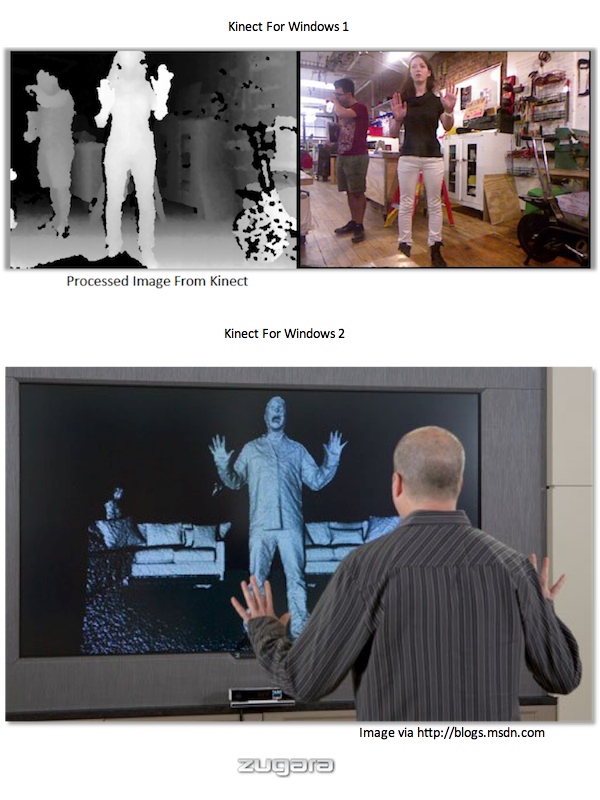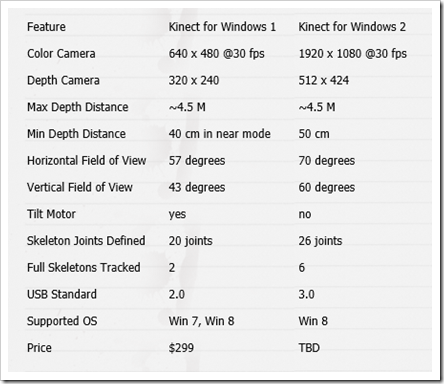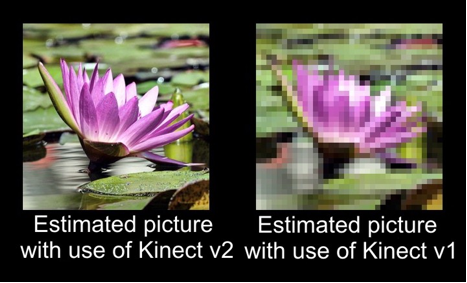Microsoft recently announced that the Kinect 2 will be available for developers July 15th and a general market release later this year. Zugara has been part of the Kinect 2 beta program since late 2013 and we can attest to the significant improvements available for the next generation Kinect 2 camera. The biggest notable difference? The higher resolution capability of the Kinect 2 camera. Though the Kinect 1 device is a vast improvement over regular webcams, the Kinect 1 is restricted by it’s lower resolution output. The comparison image below represents the visual input difference between the Kinect 1 and Kinect 2:
From a pure technical spec standpoint, the Channel 9 community on MSDN has a product spec breakdown for Kinect 1 and Kinect 2 which you can view below. More information on the Channel 9 post is here and additional Kinect 1 vs. Kinect 2 spec analysis can be found after the image below:
Zugara’s CTO, Alex, has been working with Time of Flight (TOF) technology for over 15 years. For a breakdown on how significant these spec improvements are for the Kinect 2, Alex shared the following analysis:
“The Kinect v2 face recognition, motion tracking, and resolution are much more precise than the Kinect v1. Kinect v2 uses “time of flight” technology to determine the features and motion of certain objects. IGN summarized this technology well by comparing it to sonar technology, except that this is a large improvement and more accurate. By using this technology, the Kinect v2 can see just as well in a completely dark room as in a well lit room. Although the first Kinect used similar technology, the Kinect v2 has greatly improved upon it. The Kinect v2 has 1080 resolution (HD), and from the picture below you can see the difference between images.
Kinect v2 can process 2 gigabytes of data per second, USB 3 provides almost 10x faster broadband for the data transfer, 60% wider field of vision, and can detect and track 20 joints from 6 people’s bodies including thumbs. In comparison, the Kinect v1 could only track 20 joints from 2 people. On top of this, when using Kinect v2 we are capable of detecting heart rates, facial expressions and weights on limbs, along with much more extremely valuable biometric data. The Kinect v1.0 device doesn’t have the fidelity to individually track fingers and stretching and shrinking with hands and arms but the Kinect v2 has these capabilities. It’s clear that this technology is certainly much, much, more powerful and complex than the first generation of Kinect.”
We’ll be releasing some Kinect 2 demos of our WSS and VSS Virtual Dressing Room software as well as a new Kinect 2 enabled Avoid and Capture game engine this summer. In the meantime, feel free to contact us if you’d like to see some Kinect 2 demos or talk about how Zugara can assist with your experiential marketing or retail efforts using either version of Kinect.
UPDATE December 9th, 2014: Microsoft has released updated specs for Kinect for Windows v2 SDK. You can view those updated specs here.
Load your windows based games on the cloud using high performance GPU enabled Virtual PCs accessible remotely from any PCs/Macs/iOS/Android devices with 99.9% uptime guarantee from CloudDesktopOnline.com. To learn more about services like DaaS and cloud storage visit www.Apps4Rent.com.
JUN



